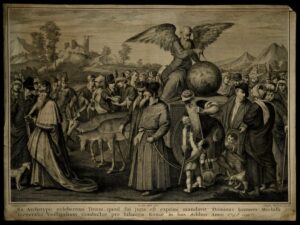Guest Post: Arturo Serrano Talks Historical Figures

This file comes from Wellcome Images, a website operated by Wellcome Trust, a global charitable foundation based in the United Kingdom. Refer to Wellcome blog post (archive). (https://commons.wikimedia.org/wiki/File:A_procession_of_historical_figures_with_a_divine_figure_draw_Wellcome_V0007577.jpg) CC-by-4.0 (https://creativecommons.org/licenses/by/4.0/)
Today, I’ve invited Arturo Serrano to talk a little bit about how he chose the historical figures he included in his upcoming book, To Climates Unknown. (Available this Thursday!)
One of my first steps when I was preparing the overarching storyline of To Climates Unknown was to do a sweeping search for historical events coinciding with the Mayflower. I did this to gain a sense of what kind of world I’d be getting myself into, because I didn’t yet feel confident enough in my knowledge of that era. I ended up I gathering what could be called a “Who’s Who” of the 17th century. By focusing on events that happened around September and October 1620, which coincides with the start of the Mayflower’s journey, I learned about Jens Munk and Hasekura Tsunenaga, who became crucial characters. That’s also how I knew I wanted to involve René Descartes in the story, even if I couldn’t at first think of a direct way to connect him to it. Only when I realized that in order to truly explore a world without the United States I was going to need to remove from the table the entire liberal tradition of political theory, the fate of Descartes became clear in my mind.
I gave much thought to the Pilgrim Fathers, and started tracing family lines to use in my novel, but abandoned that idea when I gained a clearer sense of the focus I wanted. This needed to be a story about decentering America, and I couldn’t do that properly as long as my protagonists were its founding heroes. So I tracked down a few of the Pilgrims’ immediate descendants and deliberately drove their lives to a historical dead-end. They leave the plot in the first section of the novel, as if to reinforce the point that there’s no chance of another attempt to build America in my timeline.
As I planned the subsequent chapters, which take place in later years, I discovered other characters who were just too fascinating to leave out. King Kristina of Sweden is the most salient case. She wasn’t originally on my radar, let alone in my plans for the plot, but the more I read about her, the more I realized it would be a crime to write a novel about the 17th century without mentioning her. She’s just larger than life in every way.
Another character I stumbled upon was José Celestino Mutis, who in real life participated in an expedition for the Spanish Empire, to catalog the native plants of what is now Colombia. I came across his name because in his youth he happened to be present at the 1755 earthquake in Cádiz, which is one of the key episodes in my novel, and it felt like a fun twist to have him recruited for a different type of scientific expedition.
In the later chapters, as the plot approached the present day, I began selecting more and more characters with no connection to the nobility. One of the common pitfalls in writing believable historical fiction is the tendency to make all events hinge on the choices of people in power, and during the composition of this novel I learned how easy that temptation is. Because one of the themes I explore at the end of my plot is the universality of the democratic aspiration, I made an extra effort to focus more on common people as the novel ended. Also, since a crucial reason why the colonized peoples in my fictional timeline are able to overthrow the imperial system is the rise of scientific knowledge, I picked historical figures with academic interests. That’s how I found out about Professor M. Hiriyanna in India and Paul Farnana in the Congo.
There were, of course, a handful of historical figures that would have been nice to play with, but didn’t quite fit. Since I set my timeline’s scientific revolution, and the core of the anticolonial movement, in Africa, the plot didn’t provide an opportunity to move the focus of the narration to Latin America, so very little is told there. Colombian natural philosopher Francisco José de Caldas was, regrettably, impossible to integrate into the novel.
For the earlier chapters, I had notes prepared about the royal couple of Jahangir and Nur Jahan, but the flow of events I had designed didn’t offer a usable connection to their time period. They’re the characters I would have liked to include the most.
However, I’m pretty satisfied with the cast of characters I ended up with. For the final manuscript, I had to hire nine sensitivity readers, because this is a global novel, and I’m happy that I managed to keep it global in scope.
~
Arturo Serrano was born in Colombia in 1982. In Spanish, his stories have appeared in the science fiction anthology Cronómetros para el Fin de los Tiempos and in Axxón magazine. In English, he has been published in Antimatter Magazine and Black Bough Poetry. He is part of the team of translators at bilingual science fiction magazine Constelación, and a reviewer at the blog Nerds of a Feather. He is the author of Doves & Dissenters, a pacifistic game supplement for Dungeons and Dragons Fifth Edition. To Climates Unknown is his first novel in English.

Comments